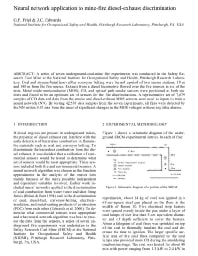Mining Publication: Neural Network Application to Mine-Fire Diesel-Exhaust Discrimination
Original creation date: October 2002
Authors: GF Friel, JC Edwards
NIOSHTIC2 Number: 20023130
In: De Souze E, Ed. Proceedings of the North American/Ninth U.S. Mine Ventilation Symposium (Jun 8-12, 2002; Kingston, Ontario, Canada). A. A. Balkema Publishers, Lisse, Netherlands; :533-538
A series of seven underground-coal-mine fire experiments was conducted in the Safety Research Coal Mine at the National Institute for Occupational Safety and Health, Pittsburgh Research Laboratory. Coal and styrene-butadiene-rubber conveyor belting were burned upwind of two sensor stations, 18 m and 148 m from the fire source. Exhaust from a diesel locomotive flowed over the fire sources in six of the tests. Metal-oxide-semiconductor (MOS), CO, and optical-path smoke sensors were positioned at both stations and found to be an optimum set of sensors for the fire discriminations. A representative set of 7,679 samples of CO data and data from the smoke and diesel-exhaust MOS sensors were used as inputs to train a neural network (NN). By testing 42,538 data samples from the seven experiments, all fires were detected by the NN within 9.67 min from the onset of significant changes in the MOS voltages without any false alarms.

NIOSHTIC2 Number: 20023130
In: De Souze E, Ed. Proceedings of the North American/Ninth U.S. Mine Ventilation Symposium (Jun 8-12, 2002; Kingston, Ontario, Canada). A. A. Balkema Publishers, Lisse, Netherlands; :533-538
- In Mine Evaluation of Discriminating Mine Fire Sensors
- In-Mine Evaluation of Smart Mine Fire Sensor
- In-Mine Evaluation of Smoke Detectors
- Mine Fire Detection in the Presence of Diesel Emissions
- Mine Fire Detection in the Presence of Diesel Emissions
- Mine Fire Detection Under Zero Airflow Conditions
- Mine Fire Source Discrimination Using Fire Sensors and Neural Network Analysis
- Multiple Type Discriminating Mine Fire Sensors
- Real-time Neural Network Application to Mine Fire - Nuisance Emissions Discrimination
- Technology News 498 - Multiple Fire Sensors for Mine Fire Detection and Nuisance Discrimination